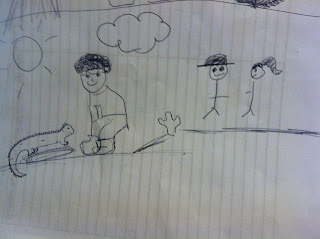I think at an idea central to this
concept is the confirmation bias. When
people look at a source like Fox News (or MSNBC, or the Huffington Post, for
that matter), we are looking for information that confirms our current feelings
and beliefs. I would assume that many Fox
News viewers do not hold liberal views about policy, the environment,
government, or social issues, and that when they see a story on fox News that
supports their position, they are more likely to believe it than someone with
more moderate views. I think the idea of
“fair and balanced” is more of a spin tactic than a true statement about the
nature of Fox News (or any news outlet for that matter)’s reporting. I think it is tough for a news outlet, whose
primary directive is to retain viewers and make money through advertisement and
viewership, to actively challenge the viewpoints of its faithful. When people’s beliefs are challenged, they
may be more likely to change the channel, which leads to lost revenue. Balancing budgets does not make for balanced
news, and it’s hardly fair to the viewer when a network’s profit margin is
placed above the potential benefit of trying to be as objective as possible. Unfortunately, anyone who relies exclusively
on a major news network for their information is going to be misinformed in
some way, whether it’s the fault of simple omissions or getting the news from a
source that wants to influence public belief to its agenda.
Challenging previously held beliefs
is a source of cognitive dissonance, and we know very well that cognitive
dissonance is uncomfortable. But, that’s
where the learning happens: at the end of our comfort zones. When our previous
beliefs do not “line up” with new information, it is sometimes difficult for us
to process. When our beliefs are
challenged, it sometimes sets off a train of re-evaluation; “Does my change of
belief on this subject affect my other ideas about the world?”
An
example could be challenging the belief that climate change is not a potentially
disastrous global problem. Perhaps if
someone were to challenge that belief, they would be able to challenge others
as well. Challenging the beliefs about
climate change could lead people to challenge and perhaps change their ideas
about leading sustainable lives, driving their cars less or carpooling, using
more energy efficient appliances, and perhaps even joining advocacy groups to
increase awareness in their neighborhoods.
The willingness to challenge those
long held beliefs is the key, and this brings me back to one of my first
posts. When individuals are willing to
challenge their previous beliefs, they often adopt a new belief in its
place. Our job as science writers is to
make science and information accessible to those who wish to challenge their
views or replace antiquated ones. When
we make the information accessible and clear in a way that doesn’t alienate or
belittle those with different views, we are ensuring that individuals who wish
to change their views will feel like they are accessing objective, meaningful information. We need to make the information available to
those people who want to change, and it is our responsibility to be the most
objective writers we possibly can to ensure that our readers (and potential “converts”)
are getting the most unbiased information we can give.

